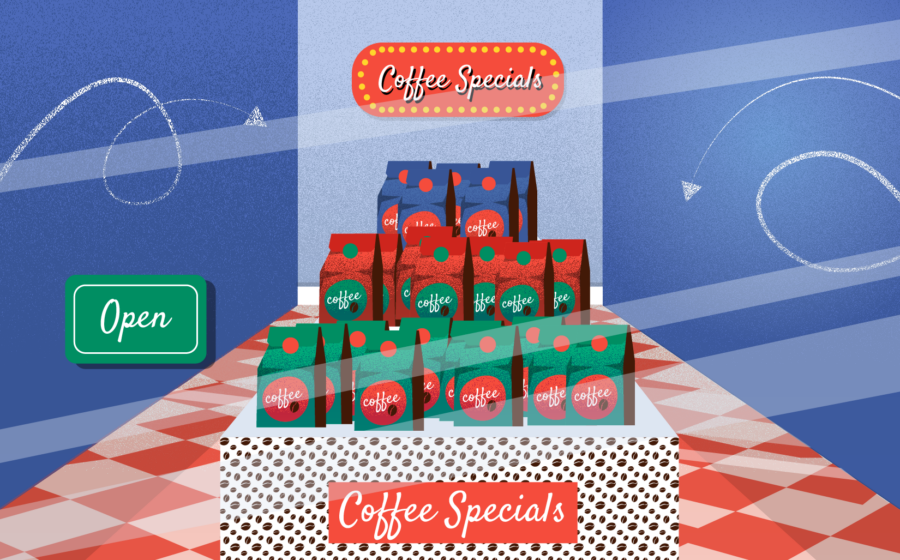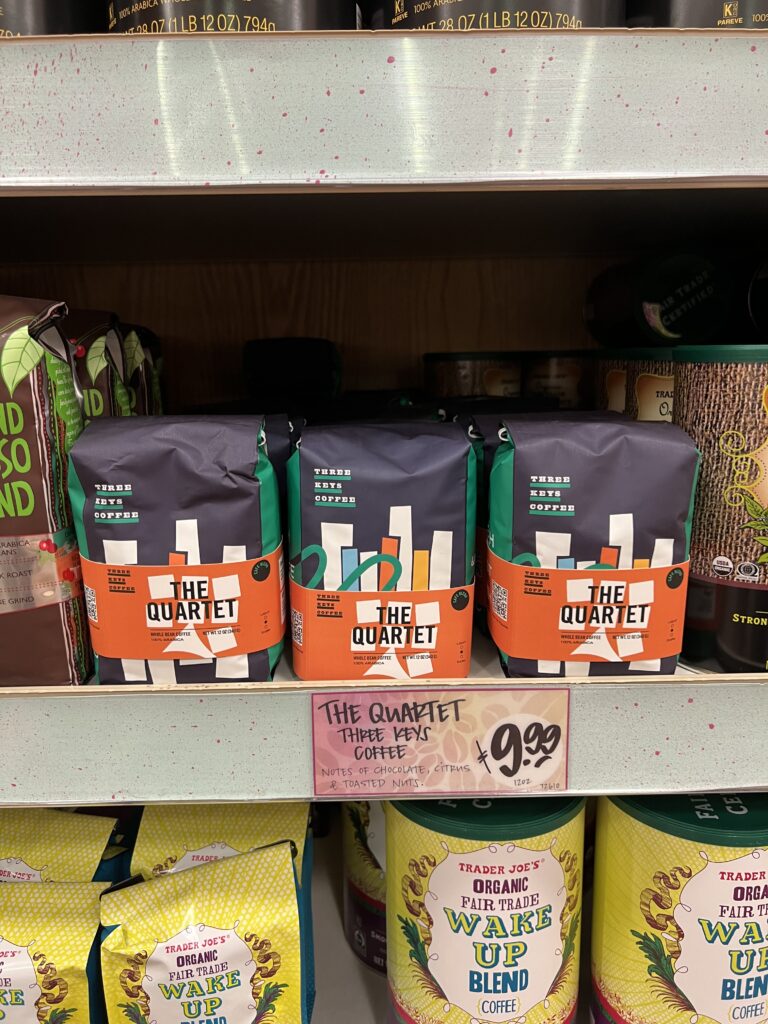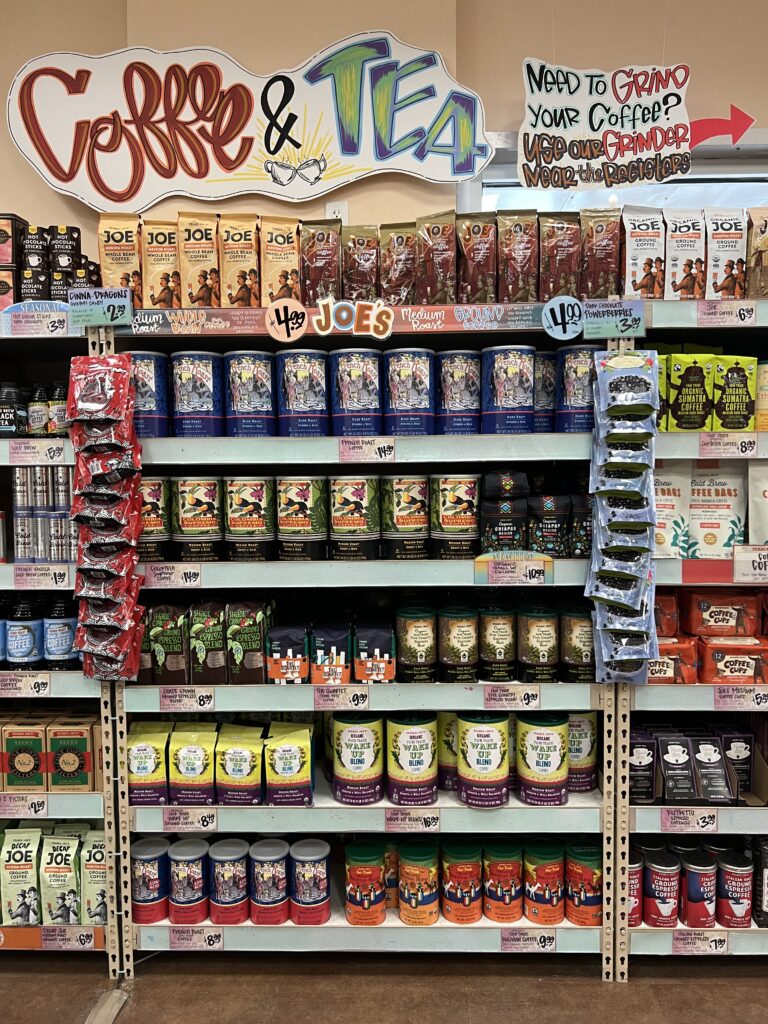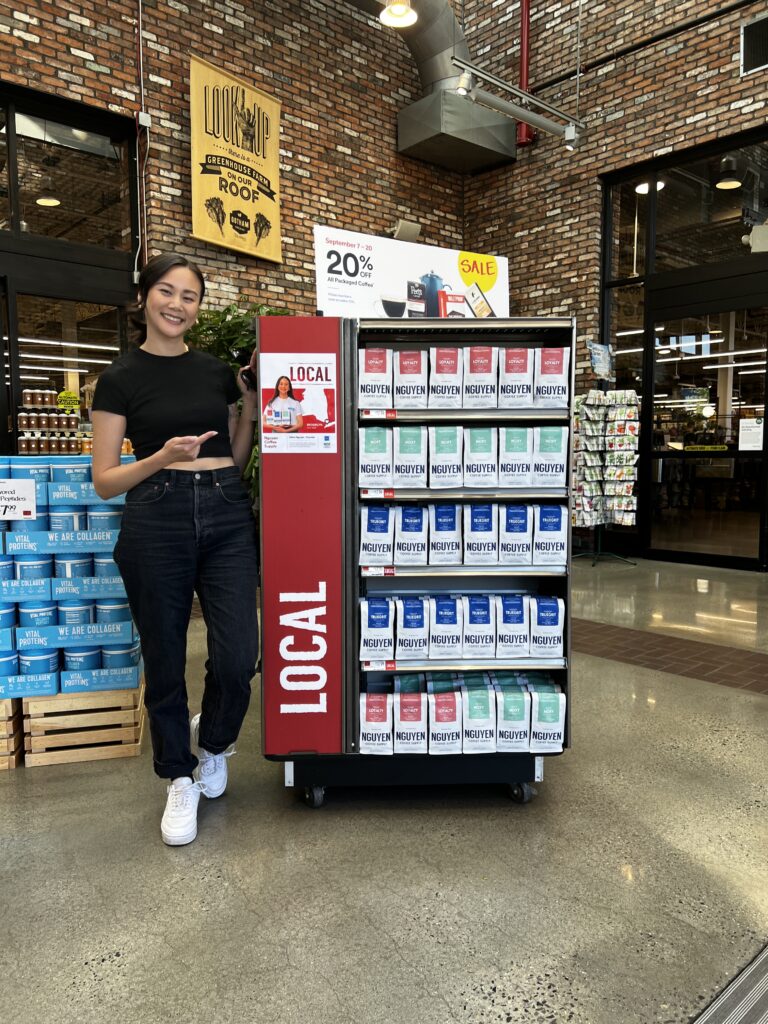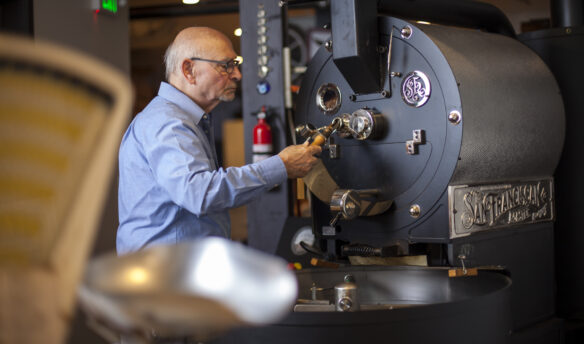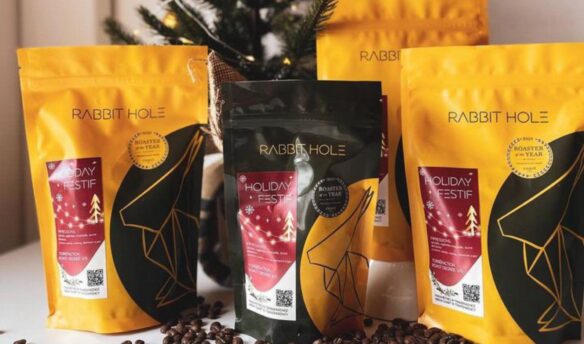The coffee aisle at most grocery stores contains the usual convenient choices: boxes of single-serve pods, pre-ground coffee in large tins, and vacuum-sealed bricks of flavored coffee in every flavor you can imagine.
While many of these grocery standbys may be comforting in their familiarity, consumer preferences and purchase behaviors are shifting—and grocery stores are pushing to stock and sell higher-quality coffee from local roasters. In the Fall 2022 National Coffee Data Trends report, the National Coffee Association found that 35% of respondents who brewed coffee at home within the past day purchased their coffee from a grocery store.
Grocery stores offer roasters a new audience. Instead of relying on patrons to frequent cafés or find their brand online, roasters can work with grocery stores and big box supermarkets to distribute their beans and potentially create a recurring source of revenue. But working with grocery distributors can create new challenges. Large-scale distributors can be difficult and impose unfavorable payment terms, and stock can sit on shelves for months. Additionally, profit margins can quickly shrink due to expenses incurred to be competitive in the grocery scene—promotional fees, liability insurance, distributor costs, etc.
Grocery stores can be a valuable sales channel for roasters looking to expand and drive growth, but success on the shelf requires more than just getting your coffee in at your local superstore. Being successful requires knowing your market and understanding the complex, and sometimes befuddling, dynamics of grocery distribution.
Single Store, Exponential Exposure
Grocery store sales can drive significant order volume for coffee roasters. However, due to notoriously low margins, money doesn’t always top a roaster’s list of reasons to pursue supermarket sales. Conventional grocery stores have an average margin of around 2.2%, while specialty markets can have a bottom-line margin range of 5-10%.
Instead, roasters leverage grocery sales to target something far more valuable: brand exposure.
Three Keys Coffee, a specialty coffee roaster based in Houston, Texas, sells coffee beans at 42 Trader Joe’s locations nationwide. After being approached by Trader Joe’s for potential placement in July 2020, the company was intrigued by the possibility of reaching thousands of customers through a single source.
“The benefit to working with a grocery store is that we can reach 10,000 people, presumably at once, by working with a single point of contact,” says Kenzel Fallen, co-founder of Three Keys Coffee. “From a simplicity perspective, knowing that you’re able to get your product out there to be seen and enjoyed and consumed by a lot of different people is something we feel has helped to increase our brand awareness.”
For Nguyen Coffee Supply, a coffee company based in Brooklyn, New York, the decision to pursue grocery store sales came from an organizational mission to educate. Nguyen Coffee Supply is the first specialty Vietnamese coffee company in the U.S. with a goal to promote robusta coffee, a coffee varietal whose popularity is quickly rising. After successfully launching a direct-to-consumer ecommerce store, Nguyen Coffee Supply was looking to diversify its revenue streams and ultimately landed on pursuing grocery store distribution.
“Much of our work is rooted in changing the narrative and perceptions, and we can only do that if we can directly relate to the consumer,” says Sahra Nguyen, founder of Nguyen Coffee Supply. “This led us to the retail channel, which aligns with our strategy and efforts to reach consumers where they’re at, to have a direct relationship. It also allows us to diversify our revenue streams as ecommerce gets really expensive.”
Nguyen Coffee Supply started selling bags of coffee in a single Whole Foods in New York City before expanding across the Northeast. Today, you can find bags in Whole Foods in six regions across the United States.
Another reason Nguyen Coffee Supply explored the retail space was the rising cost of customer acquisition across ecommerce channels. “When [we] think about the acquisition costs for retail … you can reach about 1,000 customers with visibility and awareness on the shelf. And, while there are different sets of expenses, I feel like we’re able to acquire more customers in the retail space without paying per customer required for ecommerce,” Nguyen says.
Shop Around The Grocery Store
While grocery store sales can be a valuable source of brand exposure, Logan Mahoney, Director of Business Development and Strategic Partnerships at Atomic Coffee Roasters in Beverly, Massachusetts, advises roasters to be thoughtful in choosing retail partnerships.
“Always check the set before you approach the buyers,” says Mahoney. A “set” refers to the product lineup of brands on the shelf. Mahoney’s advice is two-fold: checking a grocery store’s set provides roasters insight into what coffee brands sell well and how much the store’s target audience is willing to pay for coffee.
This information allows roasters to identify if a grocery store’s audience and product strategy align with its brand and growth goals. For example, a grocery store that sells only ground coffee may be a misalignment for a brand that prides itself on selling freshly roasted, whole-bean coffee. Or a grocery store set that consists of coffees under $15, when you know your retail price needs to be at least $20 to meet margins, may not be a match for your brand.
Additionally, while a single source such as Trader Joe’s or Whole Foods can expose a brand to thousands of potential customers, that source can easily take it away without warning. Adam Lees, a Q grader and green buyer at Kaffe Magnum Opus, a coffee roasting company specializing in wholesale partnerships, explains that coffee roasters are at the whim of grocery buyers. “At any given time, a buyer can say, ‘This isn’t selling’ and move your company to the bottom shelf. And then, two weeks later, you don’t get any orders.”
Lees emphasized the need to build a relationship with the store’s grocery manager or category buyer. This relationship can be the difference between recurring sales and being removed from the shelf.
Relationships with potential distributors are also key, as Modest Coffee found out. Modest Coffee began its grocery sales by managing individual relationships with each grocery and retail partner. But as sales and interest from other retailers grew, the company believed partnering with a distributor would usher in the next wave of growth for their business. Little did they know this distributor partnership would land them with nearly a quarter of a million dollars worth of debt when their distributor canceled a huge order.
Modest Coffee was able to bounce back and recover most of its costs, and owners Marcus and Jenni Contaldo now know how to approach potential grocery deals. “I’m never doing a nameless, faceless deal again, never,” says Marcus. “I either know the buyer and know who all the parties are involved, or I’m not doing it again.”
Learning the Retail Language
Grocery distribution relationships are complex and require a thorough understanding of how the retail industry operates, what category buyers are looking for in a potential supplier, and how to make this channel generate sales for your roastery.
“It was very challenging [to understand] all of the requirements for onboarding as a vendor. It took a lot in terms of understanding the insurance requirements, the labeling requirements, the logistics requirements….” Fallen says. “But once we went through it, anytime we had another conversation with a potential distributor or another grocery chain, I knew everything I needed to know and was fully prepared.”
Unfortunately, due to inexperience, many roasters (and other companies entering the consumer packaged goods or retail world) experience great difficulty when entering a retail partnership.
Fortunately, many larger retail chains understand the complex nature of the industry and offer programs designed to help small businesses and new suppliers succeed on the shelf. Kroger’s Go Fresh & Local Supplier Accelerator program and Whole Foods’ Local and Emerging Accelerator Program (LEAP) allow local businesses to get their product in front of category buyers and learn the ins and outs of the retail industry.
No Two Stores Are The Same
As a wholesale coffee supplier for cafés, you set your rates, timelines, and processes. Potential coffee shop clients either adhere to these standards or work with another supplier. In the grocery store world, this isn’t the case.
While there may be some wiggle room, coffee roasters must follow the store’s set policies regarding deliveries, promotions, profit margins, and more. And policies and standards can differ from store to store, providing yet another obstacle for roasters to navigate.
“Route-to-market and pricing strategy change with each retailer. A regional distributor in New York City will have a different margin requirement than a regional distributor in California,” Nguyen explains. One retailer may have a specific policy regarding their target profit margin, for example, while another is willing to work with new vendors to establish the best pricing strategy for both parties. “Working through everybody’s different margin requirements—and wanting our product to land at the same MSRP (manufacturer’s suggested retail price) in every Whole Foods store—was a big learning curve.”
Since each store has specific requirements, you may need to adjust your pricing, promotion, and distribution to secure the account. For instance, if a potential retailer requires all new vendors to work with a broker, you now need to factor that cost into your wholesale rate. Is this extra cost worth the effort to get on that particular shelf? While there’s no clear answer, a roaster must weigh these factors (lower margins, greater volume, distribution requirements, etc.) and determine if the extra effort and costs are worth pursuing the partnership.
Lees—along with nearly every other roaster interviewed—recommend meticulously reading every line of your contract with a grocery store. “You have to be really careful. A lot of times, with grocery stores and distributors, your eyes can get big, and you feel like this is the greatest opportunity,” says Lees. Examining a contract, he explains, allows roasters to fully comprehend if they can handle the volume requests, pricing structure, and delivery requirements of a grocery store chain—or if it’s more advantageous to walk away.
Find a Niche and Own It
Lees says gaining shelf space at a local supermarket or giant retailer is a competitive game. “There are thousands of roasters out there. Finding a niche in the marketplace is critical.”
Mahoney echoes Lees’ sentiment: “It’s about knowing your brand and where you’re successful regionally, and not just going for the dollars.”
Knowing your brand’s niche within the coffee industry lets you determine if grocery store distribution is the best sales channel for your company. Nguyen advises that roasters be clear and intentional about why they want to pursue grocery distribution. “How does entering retail in the supermarket space serve or not serve your goal as a business? Expansion doesn’t always mean more money; it doesn’t always mean profitability. It’s [about] getting really clear on what kind of business you want to build because retail may not be the answer for everyone.”
In the end, the advice from these roasters is clear: Grocery store partnerships can be a valuable opportunity for roasters to reach thousands of potential customers and drive sales. Success in this channel is only possible through extensive planning and research, but the thousands of people who will walk by—and perhaps even pick up—your coffee may well be worth it.

